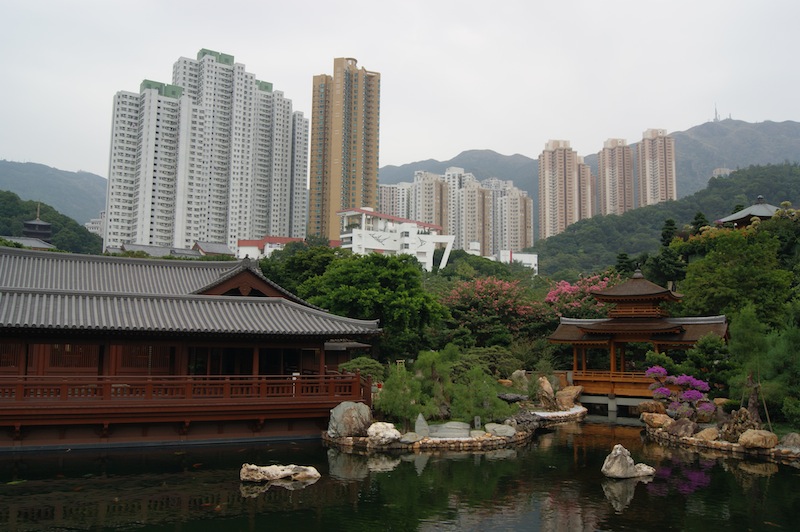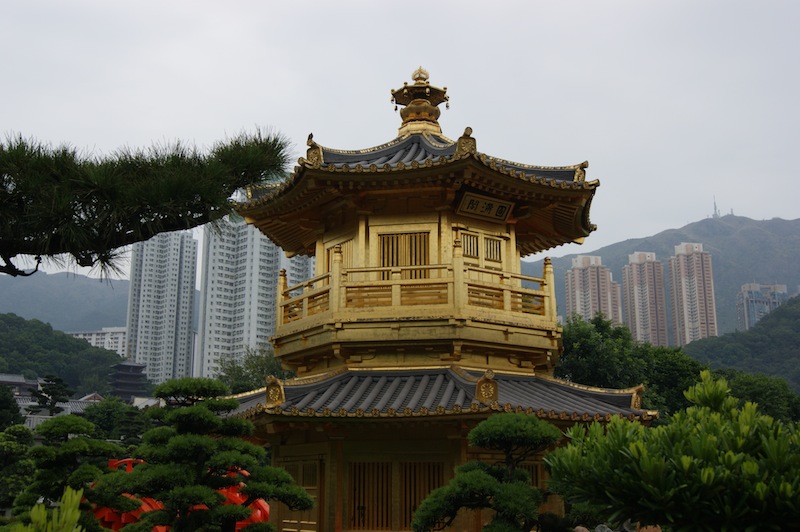It would be a day of striking contrasts – of beautiful gardens and choked and dirty streets, of seclusion and overwhelming crowds. But that’s probably like every day in Kowloon.
After several days exploring the islands of Hong Kong, it was time to stick to the mainland so in the morning we took the metro up to Diamond Hill and then walked the short distance to the Chi Lin Nunnery. Linked to it is the Nan Lian Garden, a beautifully landscaped and manicured green space that was saved from the city’s rampaging developers just a few years ago.
Inspired by gardens elsewhere in China, it exists in stark contrast to the giant tower blocks, wild green hills, shopping malls, dual carriageways and concrete that surround it. Nan Lian and similar gardens and small parks are vital to the wellbeing of Hong Kong’s population but it seems the authorities are only just waking up to that fact.

Together, the garden and the nunnery’s traditional Buddhist buildings are a haven from the noise and pollution outside, a place to escape the rush of 21st century life. As with so many other public places in Hong Kong, we were greeted by countless signs telling us what’s allowed and what’s not (don’t spit, don’t feed the fish, don’t climb, hold on tight to hand rails and so on, ad nauseum), because the authorities just can’t resist a good nag in this part of the world.
Leaving the signage behind we toured the garden, admired the handsomely sculpted trees, plants and bushes, the water features, traditional wooden buildings and giant boulders that pepper the landscape and are designed to reflect China’s geological make-up. The grounds include an exhibition of wooden scale models of historic Chinese buildings, all beautifully crafted and engineered. Beyond it, a waterfall tumbled attractively beside a vegetarian restaurant.
The nunnery was also an oasis of peace (and prayer for those of a religious bent), with small chapels dominated by giant Buddhist statues. Colourful water lilies thrived in a number of serene ponds. It really was a lovely place.

Refreshed, we made our way to Prince Edward station to do a Lonely Planet walk through some of the markets of northern Kowloon. The flower market is a riot of colour and plants, their gorgeous scents clashing with the rather more urban odour of festering drains that seemed to follow us around. We walked down a street lined with aquariums stocked with tropical fish, and pet shops with kittens and puppies crammed disturbingly into small glass boxes.
We visited the jade market but found little that we liked, and forced our way through the tat of the Tung Choi Street market. Stalls overflowed with fake designer goods and cheap, everyday household clobber and, if nothing else, it was atmospheric. Around us, run-down apartment blocks sprouted rusting neon signs that hovered precariously above the street. This was the Hong Kong I’d seen in photos and films, a Kowloon at work and play. It was bonkers – noisy and smelly, tatty and oppressive, full of people – and for some reason it reminded me of Blade Runner. I loved it.
By the time we’d finished our trawl of the streets, I was pretty spent and tetchy. Combined with a crap night of sleep on both our parts (not helped by dad ringing at 4.45am having forgotten we were away), I really wasn’t feeling up to much.

Still, the evening found us in the beating social heart of Hong Kong Island, Soho and Lan Kwai Fong. We walked the steep streets and made use of the escalators that climb the various levels, discovering the old Hong Kong nestling behind the corporate, gleaming and modern skyscrapers. It’s a district of loud and busy bars and restaurants, populated by office workers of all nationalities out for a good time, another amazing part of the city.
We ate at a small French bistro, Pastis, and drank in a few bars – Zinc (music too loud) and Lotus (much more relaxed and right by the escalator). But by then I was suffering, feeling rather under the weather. Too much rich food and hard living was taking its toll.
Time to take it slower…

